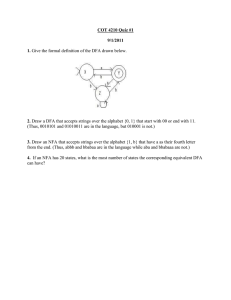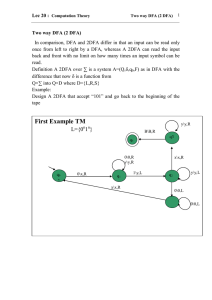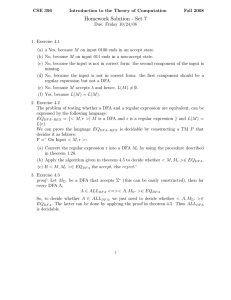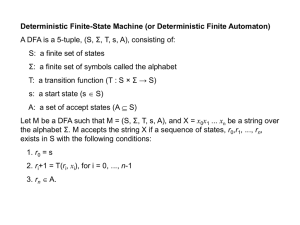IRJET- Partition Method for DFA Minimization
advertisement
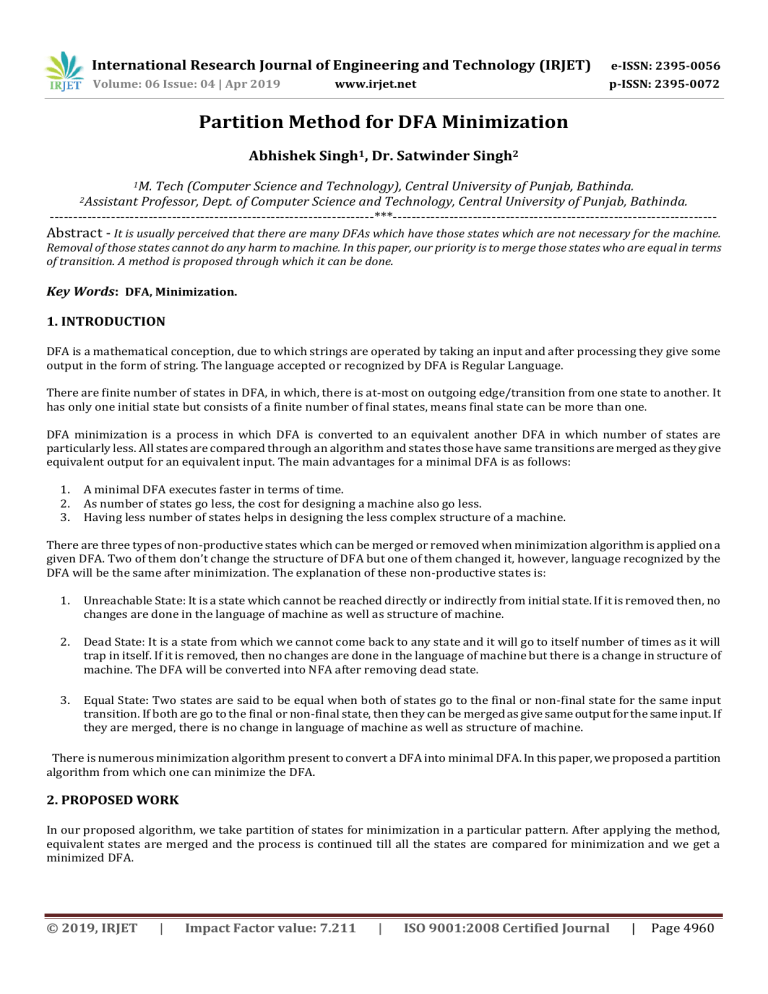
International Research Journal of Engineering and Technology (IRJET) e-ISSN: 2395-0056 Volume: 06 Issue: 04 | Apr 2019 p-ISSN: 2395-0072 www.irjet.net Partition Method for DFA Minimization Abhishek Singh1, Dr. Satwinder Singh2 1M. Tech (Computer Science and Technology), Central University of Punjab, Bathinda. Professor, Dept. of Computer Science and Technology, Central University of Punjab, Bathinda. ---------------------------------------------------------------------***--------------------------------------------------------------------2Assistant Abstract - It is usually perceived that there are many DFAs which have those states which are not necessary for the machine. Removal of those states cannot do any harm to machine. In this paper, our priority is to merge those states who are equal in terms of transition. A method is proposed through which it can be done. Key Words: DFA, Minimization. 1. INTRODUCTION DFA is a mathematical conception, due to which strings are operated by taking an input and after processing they give some output in the form of string. The language accepted or recognized by DFA is Regular Language. There are finite number of states in DFA, in which, there is at-most on outgoing edge/transition from one state to another. It has only one initial state but consists of a finite number of final states, means final state can be more than one. DFA minimization is a process in which DFA is converted to an equivalent another DFA in which number of states are particularly less. All states are compared through an algorithm and states those have same transitions are merged as they give equivalent output for an equivalent input. The main advantages for a minimal DFA is as follows: 1. 2. 3. A minimal DFA executes faster in terms of time. As number of states go less, the cost for designing a machine also go less. Having less number of states helps in designing the less complex structure of a machine. There are three types of non-productive states which can be merged or removed when minimization algorithm is applied on a given DFA. Two of them don’t change the structure of DFA but one of them changed it, however, language recognized by the DFA will be the same after minimization. The explanation of these non-productive states is: 1. Unreachable State: It is a state which cannot be reached directly or indirectly from initial state. If it is removed then, no changes are done in the language of machine as well as structure of machine. 2. Dead State: It is a state from which we cannot come back to any state and it will go to itself number of times as it will trap in itself. If it is removed, then no changes are done in the language of machine but there is a change in structure of machine. The DFA will be converted into NFA after removing dead state. 3. Equal State: Two states are said to be equal when both of states go to the final or non-final state for the same input transition. If both are go to the final or non-final state, then they can be merged as give same output for the same input. If they are merged, there is no change in language of machine as well as structure of machine. There is numerous minimization algorithm present to convert a DFA into minimal DFA. In this paper, we proposed a partition algorithm from which one can minimize the DFA. 2. PROPOSED WORK In our proposed algorithm, we take partition of states for minimization in a particular pattern. After applying the method, equivalent states are merged and the process is continued till all the states are compared for minimization and we get a minimized DFA. © 2019, IRJET | Impact Factor value: 7.211 | ISO 9001:2008 Certified Journal | Page 4960 International Research Journal of Engineering and Technology (IRJET) e-ISSN: 2395-0056 Volume: 06 Issue: 04 | Apr 2019 p-ISSN: 2395-0072 www.irjet.net Algorithm Input: Deterministic Finite Automata Output: Minimized Deterministic Finite Automata Algorithm: Take a DFA with Initial State Qi and Final State Qj. Take Partition in the form of [ (Total number of states/2) +1]. Take floor value of division. Take first partition starting from initial State that is Q0. Check in the partition whether any state equivalent or not. If two state are equivalent then merge them and move to next partition. If any state from the current partition is not equivalent then move to next partition. States who have already merged cannot be the part of next partition but they will count in total number of states. Take next partition starting from next state in incremental numeric form for example: if in first partition if Q0 is merge other state take next partition from Q1 if Q0 and Q1 both are equivalent to some other states take partition from Q2 and so on. Continue this process until all the states are covered. For last partition take the remaining ones After this process all the equivalent states are merged and DFA will become minimized DFA. For equivalent state, here we consider that two state P and Q are said to be if both P and Q δ (P, x) and δ (Q, x) goes to final state or non-final state for every input string x. 3. EXPERIMENTS AND RESULTS The experiments are done in the JFLAP tool in default settings. Input: Given DFA Table 1: Transition Table of DFA States 0 1 Q0 Q1 Q2 Q3 Q4 Q0 Q3 Q3 Q1 Q1 Q2 Q1 Q1 Q4 Q4 Fig 1: Transition Diagram of DFA © 2019, IRJET | Impact Factor value: 7.211 | ISO 9001:2008 Certified Journal | Page 4961 International Research Journal of Engineering and Technology (IRJET) e-ISSN: 2395-0056 Volume: 06 Issue: 04 | Apr 2019 p-ISSN: 2395-0072 www.irjet.net Now according to Algorithm, first partition is taken according to the formula and is in between three states and the table is given below States 0 1 Q0 Q1 Q2 Q0 Q3 Q3 Table 2: First Partition Table Q2 Q1 Q1 In this table, it is clear that states Q1 and state Q2 are equivalent since in both Q1 and Q2., transition of Q1 on 0 goes to Q3 and on 1 it goes to Q1 && Q2 on 0 goes to Q3 and on 1 it goes to Q1. Hence, they are equivalent state. So, we merge them (Q12). Now for the next partition we start from the state Q3 the table is given below. States Q3 Q4 Q0 0 1 Q1 Q1 Q0 Table 3: Second Partition Table Q4 Q4 Q2 Here in this partition, it is clear that state Q3 and state Q4 are equivalent states. Transition of Q3 on 0 is Q1 and on 1 it is Q4 && Q4 on 0 is Q1 and on 1 it goes to Q4. Now, according to algorithm all the states cover we stop here and make a minimized DFA with the help Of the JFLAP tool. Now our minimized DFA is given below: Fig 2: Minimized DFA After applying partition, we get minimized DFA. Fig 3: Multiple Run of Strings in DFA © 2019, IRJET | Impact Factor value: 7.211 | ISO 9001:2008 Certified Journal | Page 4962 International Research Journal of Engineering and Technology (IRJET) e-ISSN: 2395-0056 Volume: 06 Issue: 04 | Apr 2019 p-ISSN: 2395-0072 www.irjet.net Fig 4: Multiple Run of Strings in DFA Figure 3 and figure 4 represents the strings that are accepted before and after minimization on given DFA respectively. It is clear from both the figures that there is no change in language of DFA, strings that are recognized by DFA before minimization are also recognized even after applying minimization. 4. CONCLUSION In this experiment, we proposed a minimization partition method from which by partitioning the states according to the formula one can minimize the DFA by merging equivalent states and removing dead and unreachable states. All the experimentation is done through JFLAP tool. After the minimization, it is checked that the DFA is successfully minimized with no change in structure and accepting language by running the few examples on DFA. REFERENCES [1] lmeida, M., Moreira, N., & Reis, R. (2007). On the performance of automata minimization algorithms. In Proceedings of the 4th Conference on Computation in Europe: Logic and Theory of Algorithms, pp. 3-14. [2] Amit Kishor Shukla, A. S. (December 2015). State Minimization Approach in Deterministic Finite Automatausing Inefficient STate Elimination Approach. Internation Journal of Advance Research in Computer Science and Management Studies, Vol 3, Issue 12, pp 20-28. [3] Basten, H. J. S. (2011). Ambiguity detection methods for context-free grammars (Doctoral dissertation, University of Amsterdam). [4] Berry G. and Sethi R. (1986), From Regular Expressions to Deterministic Automata, Theoretical Computer Science, Vol. 48 pp. 117-126. [5] Bruggemann Klein A.(1992), “Regular Expressions into Finite Automata,” Springer link Lecture notes in Computer Science, Vol.583 pp. 87-98. [6] Champarnaud, J. M., Ponty, J. L., &Ziadi, D. (1999). From regular expressions to finite automata. International journal of computer mathematics, Vol 72(4), pp 415-431. [7] Chang, C. H., & Paige, R. (1992). From regular expressions to dfa's using compressed nfa's. In Annual Symposium on Combinatorial Pattern Matching, pp. 90-110. Springer, Berlin, Heidelberg. [8] Chang, C. H., & Paige, R. (1997). From regular expressions to DFA's using compressed NFA's. Theoretical Computer Science, Vol 178(1-2), pp 1-36. [9] Chhabra, T., & Kuymar, A. (2012). New heuristics for conversion of Deterministic finite automata to Regular expression. International Journal of Advanced Research in Computer Science, 3(4). [10] Choubey, A., & Ravi, K. M. (2013). Minimization of deterministic finite automata with vague (final) states and intuitionistic fuzzy (final) states. Iranian Journal of Fuzzy Systems, 10(1), 75-88. [11] Gruber, H., & Holzer, M. (2015). From finite automata to regular expressions and back—a summary on descriptional complexity. International Journal of Foundations of Computer Science, Vol 26(08), pp 1009-1040. © 2019, IRJET | Impact Factor value: 7.211 | ISO 9001:2008 Certified Journal | Page 4963

